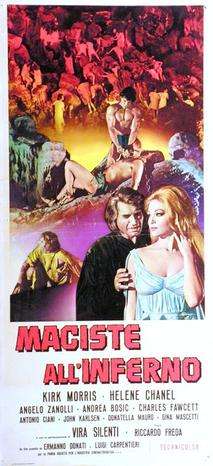The Witch's Curse
The Witch's Curse (Italian: Maciste all'inferno, lit. 'Maciste in Hell')[2] is a 1962 peplum-fantasy film, directed by Riccardo Freda.
| The Witch's Curse | |
|---|---|
 | |
| Directed by | Riccardo Freda |
| Produced by | |
| Screenplay by | |
| Story by | Ennio De Concini[1] |
| Starring | |
| Music by | Carlo Franci[1] |
| Cinematography | Riccardo Pallottini[1] |
| Edited by | Ornella Micheli[1] |
Production company | Panda Cinematografica[1] |
| Distributed by | Regional |
Release date |
|
Running time | 91 minutes[1] |
| Country | Italy[1] |
| Box office | ₤277 million |
Plot
In the mid 1500s a witch is burned in Scotland and places a curse on the inhabitants before she dies. One hundred years later the tree she was chained to and burned still stands with no one daring to destroy it. The curse remains by forcing women to commit suicide. The descendant of the witch, Martha Gunt, is sentenced to be burned for witchcraft.
As she is placed in a prison cell, Maciste comes forth to fight evil. When he uproots the cursed tree he finds an entrance to Hell where he attempts to find the original witch to rescind her curse and attempts to help the damned from their plight.
Cast
- Kirk Morris as Maciste
- Hélène Chanel as Fania
- Vira Silenti as Martha Gaunt
- Andrea Bosic as Judge Parrish
- Charles Fernley Fawcett as the Doctor
- Remo De Angelis as Prometheus
- John Karlsen
- Gina Mascetti
- Puccio Ceccarelli
Production
The Castellana caves which still serve as a tourist attraction, were used for the underground scenes.[3] The sequences set in the Hell were entirely filmed in the Castellana Caves, in the province of Bari.[4] Maciste, the leading character, was turned during the filming into an almost mute character as Freda was very unhappy with the acting skills of the main actor Kirk Morris.[4] The film is referred as "an interpretation of mythology cum the gothic horror genre".[5]
Release
The Witch's Curse was released in Italy on April 11, 1962.[1] It grossed a total of 277 million Italian lire domestically in Italy.[1]
References
Footnotes
- Curti 2017, p. 318.
- Louis Paul. Italian Horror Film Directors. McFarland & Co Inc. ISBN 0786487496.
- Hughes 2011, p. 11.
- Paolo Mereghetti. Il Mereghetti: dizionario dei film 2002. Baldini & Castoldi, 2001. ISBN 8884900875.
- Louis Paul (2011). Italian Horror Film Directors. McFarland & Co Inc. ISBN 9780786461134.
Sources
- Curti, Roberto (2017). Riccardo Freda: The Life and Works of a Born Filmmaker. McFarland. ISBN 1476628386.CS1 maint: ref=harv (link)
- Hughes, Howard (2011). Cinema Italiano - The Complete Guide From Classics To Cult. London - New York: I.B.Tauris. ISBN 978-1-84885-608-0.CS1 maint: ref=harv (link)
- Paul, Louis (2005). Italian Horror Film Directors. McFarland. ISBN 978-0-7864-8749-3.CS1 maint: ref=harv (link)